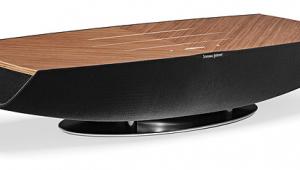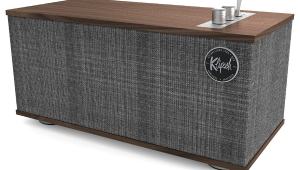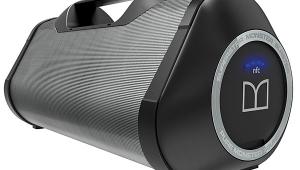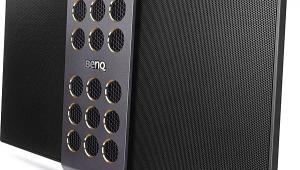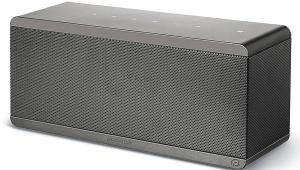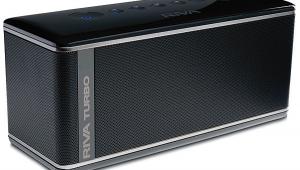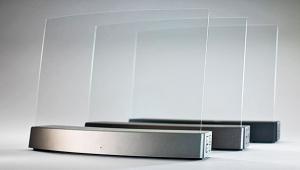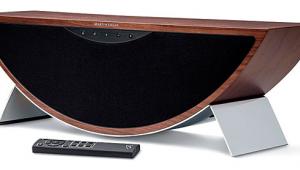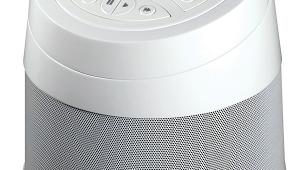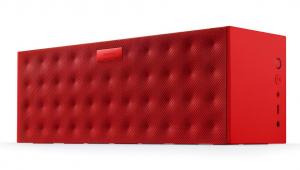Review: RockSteadyXS
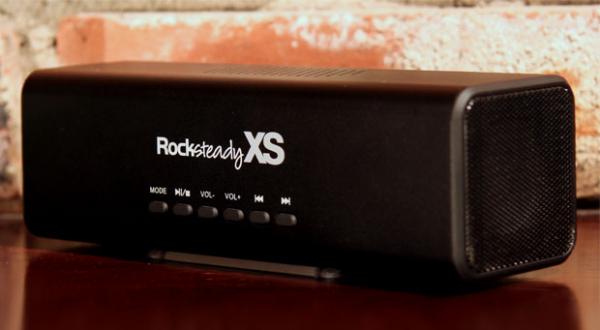
Bluetooth speakers are like cheap econobox cars: Even in normal daily use, you're likely to push them to their limits. Most of the compact Bluetooth speakers I test put out 81 to 87 dB at 1 meter, loud enough for casual listening but not loud enough to get your foot tapping and your head bobbing.
Killer Concepts promises its RockSteadyXS speaker puts out 100 dB, about what a decent home-theater-in-a-box system can deliver. The company doesn't specify how they got that 100 dB measurement, but it does seem at least somewhat plausible. The internal amps are rated at 6 watts per channel peak, which would mean the RocksteadyXS's drivers would need a 92 dB sensitivity to hit 100 dB at 1 meter. So it's possible. Still, looking at the 6.2-inch-long extruded aluminum enclosure, it's a little hard to believe.
Unusually, the RockSteadyXS's drivers are at the ends of the enclosure, with the passive radiator on top. The front of the enclosure has volume controls plus playback controls for a connected Bluetooth device. The back has a micro USB input for charging, a power switch,and a 3.5mm analog input.
Plus-WAY cool feature alert!-the XS has a full-size USB input that lets you play MP3s from a USB stick. You can use the playback controls on the front to skip tunes. So you can't navigate all that easily, but you can, say, put 6 albums worth of MP3s on a stick and skip to the album you want. Thus, for long trips you can bring a USB stick full of music to keep you going when you get bored with the music on your phone.
Here's one downside: All the other compact Bluetooth speakers I can remember reviewing shut themselves off after several minutes of not being used. The XS doesn't. If you leave it on, the battery will run down within a couple of days.
Note, though, that a new version, the RocksteadyXS 1.5 with Speakerphone, will add speakerphone function (with pickup/hangup directly from the unit), a dual-purpose USB port that can also be used to charge mobile devices, and a low battery warning notification, and more new features/functions. The company says the new version will be acoustically identical to the original.
Power or poser?
To find out if the RockSteadyXS really puts out the kick it claims it does, I called in ace West Coast listener and L.A. jazz musician Will Huff to give it a listen with me. I set it up in a comparison with a few other compact Bluetooth speakers: the Braven BRV-1, the Native Union Switch, and the Soundmatters FoxL Dash 7. I connected them to my custom-built testing switcher, which lets me match levels precisely and switch instantly among the products under test. I covered all the speakers with black fabric so for Will, at least, the test was blind.
So does the XS deliver on its promise of high volume? Yes. When I did my MCMäxxx™ test-cranking up Mötley Crüe's "Kickstart My Heart" until until it sounds harsh or distorted, then backing off the volume just a hair and noting the maximum usable volume at 1 meter, or measuring it at max volume if it sounds clean enough-the XS put out 91 dB at max volume, which is +4 to +5 dB better than competing compact BT speakers I've recently measured. Measured at 20 cm instead of 1 meter, it does actually hit 100 dB.
It's an easily noticeable difference. Other compact Bluetooth speakers tend to sound strained when asked to fill a large room, but as I write this, I'm listening to L.A. saxophonist Terry Landry's neo-bossa recording Amazonas at a nice volume in my large listening room, and the XS doesn't sound stressed at all.
Will found that for a lot of the music he listens to, the RockSteadyXS sounded great. "It's a light and airy sound-it's almost like it has a bit of a surround-sound effect," he said, probably reacting to the side-firing position of the XS's drivers. "When I played the Pancho Sanchez tune 'Dizzy's Dashiki,' it really brought out the horns. I think it's great for light music, jazz, and mood listening, but the sound is too thin for rock. There's not enough bass or midrange punch to make a tune like Creed's 'One' enjoyable."
I agree with Will 100% on this one. The XS always sounds a bit thin, a bit trebly, and a bit coarse, but the overall tonal balance is really nice for most of what I listen to. It sounded good with Amazonas, Ron Carter's CTI classic Blues Farm, and other jazz recordings. It even handled lighter rock like Led Zeppelin's "Dancing Days," Toto's "Rosanna" and Steely Dan's "Aja" well.
Heavier fare, like the Cult's Electric, gets a little blarey because of the lack of bass to balance out the treble. But if Killer Concepts had tried to get more bass from those little drivers, they'd probably have gotten more distortion in the bargain. If you want to rock out, better get something bigger.
Measurements
Frequency response
152 Hz to 12.8 kHz, ±4.4 dB 0° on-axis, ±5.1 dB 0° to 30° avg
MCMäxxx™ maximum level test (1 meter)
91 dB
Frequency response measurements were taken with a Clio FW audio analyzer and the MIC-01 measurement mike designed for use with Clio. The measurements above 300 Hz were done at a distance of 0.5 meters with the device atop a 2-meter stand using quasi-anechoic MLS technique. The blue curve in the accompanying graph shows the response at 0° on-axis; the green curve shows the average of measurements taken at 0°, 10°, 20°, and 30° horizontally. I measured from the front of the unit, at a roughly 90° angle from the drivers, because that's the way most people will probably listen to the XS. To measure response below 300 Hz, I did a ground plane measurement at 1 meter. The ground plane result was then spliced to the quasi-anechoic curves. The ground plane measurement was smoothed to 1/6th octave; quasi-anechoic measurements to 1/12th octave. All measurements were taken using the 3.5mm line input, feeding the left channel only.
The XS shows a bit of a "smiley" response, with no real bass response but the lower mids (from about 250 to 600 Hz) turned up and the mid-treble (from about 6 to 12 kHz) boosted, too. But at 0° it measures pretty flat overall. The more you move off-axis, the more you'll hear a boost in the mid-treble; you can see that unusually, the averaged 0° to 30° response shows more treble output than the on-axis response.
Bottom line
So what we have here is an audio product that actually pretty much delivers on its claims of superior output. Not a first, but a rarity for sure. Some people won't like the XS because it doesn't have enough bass. But a lot of people will like it because, unlike its competitors, which always seems to be at the edge of their capabilities, the XS really can put out decent volume without a lot of distortion.
